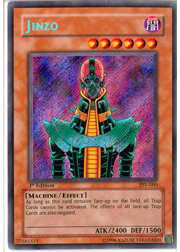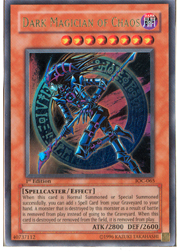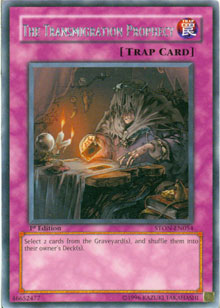Wow. I don’t think many people predicted this one.
 If you haven’t seen it yet, the new Advanced Format list taking effect March 1st made its debut last week over on the official Yu-Gi-Oh! TCG website and the judge forums, and one of the biggest surprises was the Forbidding of Call of the Haunted in favor of bringing back the long-absent Monster Reborn. The announcement sent ultra rare versions of the card from a secondary market value of five or six bucks to north of 25, an astounding leap that happened overnight. The Advanced list makes a minimal number of generally subtle changes to the Advanced environment, but the return of Monster Reborn was a big, big exception.
If you haven’t seen it yet, the new Advanced Format list taking effect March 1st made its debut last week over on the official Yu-Gi-Oh! TCG website and the judge forums, and one of the biggest surprises was the Forbidding of Call of the Haunted in favor of bringing back the long-absent Monster Reborn. The announcement sent ultra rare versions of the card from a secondary market value of five or six bucks to north of 25, an astounding leap that happened overnight. The Advanced list makes a minimal number of generally subtle changes to the Advanced environment, but the return of Monster Reborn was a big, big exception.
Now duelists are left wondering two things: how will the return of Monster Reborn affect tournament play, and why is it even back anyway? Today I want to explore those two issues.
Interrogative Speculation
The question of why Monster Reborn returned is a surprisingly interesting one with more answers than you might first suspect. Ridding the game of Call in favor of Reborn comes with some competitive costs that could be viewed as narrowing the skill gap between average and more experienced players: something traditionally seen as a negative. Never again will we see a patient player over-commit to his or her spell and trap zone in an effort to draw out Heavy Storm, only to chain Call and bring back Sangan, Card Trooper, or Jinzo and turn the tables on the opponent. Or at least, we won’t see it for the next six months.
We also lose similar "sucker plays" like waiting to bait out an attack and then brick-walling with a big monster, or special summoning Jinzo on the chain with Call in response to the activation of a trap card. All three of these types of plays took at least some measure of skill and helped reward those players who’d put in the minimal amount of time and the oft-considerable amount of discipline to perform them regularly.
So yeah, we lose a few basic skill moves, but what we get back might be far more intriguing.
One of the big results of this Forbidden/Limited swap that I don’t think anybody is really discussing is what this change means on a design level. There are a lot of cards still in the environment that act a lot like Call of the Haunted: Birthright and the new Escape from the Dark Dimension immediately spring to mind, but there are a few more out there too. When you read that just now, your immediate reaction was probably to think, "But Jason, those cards are nothing like Call of the Haunted—Call’s generic, while those cards require specific monsters." If that was in fact your reaction, then pat yourself on the back because you just reached the point before I did.
Special summoning at will on your opponent’s turn is now a themed mechanic.
 You can still use trap cards to special summon Jinzo in your opponent’s end phase and hose his or her Royal Decree, but you’re going to have to play a themed deck to do it. The value of equivalent cards that didn’t see play in the past, like the aforementioned and much-maligned Birthright, suddenly increases. In the future, upcoming deck themes will be able to use similar cards that grant them this exclusive ability, and they’ll be one notch better in competitive environments because of it. If you’re the type of duelist who likes to look at the Japanese environment every now and then, you might already be aware that there are two Call of the Haunted-type cards in the upcoming Light of Destruction booster set, which we’re still a few months removed from here in TCG territory. When those cards arrive, they’re going to be a bigger deal since there won’t be a generic equivalent in Advanced play. In the past, a lot of the Yu-Gi-Oh! TCG’s bigger theme decks fizzled out because they just weren’t as good as a stack of your 40 favorite, thematically unrelated cards. I think the trading of Call of the Haunted for Monster Reborn is a strong step in the right direction when you consider the swap in this context.
You can still use trap cards to special summon Jinzo in your opponent’s end phase and hose his or her Royal Decree, but you’re going to have to play a themed deck to do it. The value of equivalent cards that didn’t see play in the past, like the aforementioned and much-maligned Birthright, suddenly increases. In the future, upcoming deck themes will be able to use similar cards that grant them this exclusive ability, and they’ll be one notch better in competitive environments because of it. If you’re the type of duelist who likes to look at the Japanese environment every now and then, you might already be aware that there are two Call of the Haunted-type cards in the upcoming Light of Destruction booster set, which we’re still a few months removed from here in TCG territory. When those cards arrive, they’re going to be a bigger deal since there won’t be a generic equivalent in Advanced play. In the past, a lot of the Yu-Gi-Oh! TCG’s bigger theme decks fizzled out because they just weren’t as good as a stack of your 40 favorite, thematically unrelated cards. I think the trading of Call of the Haunted for Monster Reborn is a strong step in the right direction when you consider the swap in this context.
But that’s not to say that this change doesn’t introduce new challenges of skill to replace the ones lost, either. Not at all. This game continues to make graveyard management more and more important with every passing month, but up until now all that really meant was either jamming stuff into your yard as fast as possible, or keeping stuff out of your opponent’s. When it comes down to it, that’s not really very sophisticated, is it? Either you have Banisher of the Radiance out or you don’t, and while that certainly lends a tad more strategy to the game, it does very little to add tactical depth. In this new post-Phantom Darkness era, graveyard management is a whole new beast.
Dark Armed Dragon is a great example of the evolution in this part of the game system: having more than three of a particular card in the graveyard isn’t enough to bring the Dragon out—you actually have to limit the contents of your graveyard as well, resulting in a card that’s a bit tougher to use than it might have been had its text been written just slightly differently.
Enter Monster Reborn—now keeping cards out of your own graveyard isn’t just an issue for Dark Armed Dragon decks, but virtually every deck out there that runs monsters. I’ve only been playing this list for an amount of time measurable in hours, but I’ve already had everything from my own Zombie Master cards, to Banisher of the Radiance, and even freaking Destiny Hero - Diamond Dude (!) ripped from my graveyard and then thrust toward me with bludgeoning motions. While the depth of the concern may vary, a good player must always consider just what his or her to-graveyard plays might mean for the future of the duel. That introduces a facet of skilled play that we haven’t seen in years. The graveyard just keeps getting tougher and tougher to master, and that’s good news for the players with the experience to adapt.
The Chaos and Commander Conundrum
 On that note, I can’t really write about Monster Reborn without mentioning Dark Magician of Chaos and Destiny Hero - Disk Commander, can I? Given that my last few paragraphs were focused on the issue of defensive graveyard management, this seems to be the perfect time to discuss them.
On that note, I can’t really write about Monster Reborn without mentioning Dark Magician of Chaos and Destiny Hero - Disk Commander, can I? Given that my last few paragraphs were focused on the issue of defensive graveyard management, this seems to be the perfect time to discuss them.
There are a vast number of cards you don’t want your opponent taking from you with Monster Reborn. That Zombie Master? Under my opponent’s control, it quickly became several of my Zombie Masters thanks to the "Special Summon 1 Level 4 or lower Zombie-Type Monster from either player's Graveyard" line. Traitorous little varmints. My Diamond Dude did indeed net my opponent a free spell card, and Banisher messed me up too. But still, the sheer potential of those examples can’t compare to the damage done by pilfering Dark Magician of Chaos or Disk Commander. If you thought bringing either monster back from the graveyard was good when you were using your own, it’s even more brutal when you’re preventing your opponent from making the move him- or herself.
There’s been a lot of debate lately about whether or not the fact that you can now steal either of these cards from your opponent validated their survival in the March 1st format. I’m not really here to pick sides in that discussion. Instead, I want to quickly evaluate the obvious impact of Monster Reborn’s return in this context: that being an increase in risk when you play either of these monsters.
In the recent past, dropping Destiny Hero - Disk Commander was an automatic and highly desirable play for a number of decks. There was no reason not to pitch Disk Commander if you had the chance to do so for a discard-costed effect, since he was virtually useless in your hand. The same will probably hold true in many situations come March, but personally, if the game state is complicated with my opponent holding more than four cards, and he or she hasn’t used Monster Reborn yet, I might think twice about when I discard Commander. I’m going to be thinking harder and harder as my opponent continues drawing cards without playing Reborn too, to the point that I may not activate Destiny Draw at times when I’d want to do so. The same goes for Dark Magician of Chaos, minus the Destiny Draw and plus any other card that would let me discard the Magician. Even if the concern of a "borrowed" Magician only affects one in ten of my games, that’s still another decision I had to make, and not one I took lightly.
Having some main-decked recourse to busted plays like The Dark Creator special summoning Magician or Commander is kind of nice too, and I think that while duelists may be divided in their thoughts on the survival of these two cards, everybody can agree that playing them is going to be a bit trickier come March 1st. I welcome that shift.
So, What Does It Mean For You?
To shorten down my nice wall of text, the return of Monster Reborn means a few things on practical levels. First off, every card that was reminiscent of Call of the Haunted just got better in Call’s absence, and the people who design new cards have another exclusive offering to make theme decks attractive to the competitive crowd. Any deck that can special summon at spell speed 2 gets a boost because of that fact.
 Graveyard management becomes more challenging, requiring an increased level of skill. There’s more thought added to a lot of processes that became viciously routine over the past year, and that’s going to manifest at big tournaments. I expect to hear some complaining about, "he sacked into Reborn, took my Disk Commander, and won," but what my brain will hear is, "I didn’t manage my graveyard as carefully as I could have, and lost because of it." I don’t expect to be hearing this from top players as often as the less experienced ones, and the truly superb duelists will find ways to counter such an attempt from their opponents more often than not. The Transmigration Prophecy, Hero’s Rule 2, and similar cards might see more use.
Graveyard management becomes more challenging, requiring an increased level of skill. There’s more thought added to a lot of processes that became viciously routine over the past year, and that’s going to manifest at big tournaments. I expect to hear some complaining about, "he sacked into Reborn, took my Disk Commander, and won," but what my brain will hear is, "I didn’t manage my graveyard as carefully as I could have, and lost because of it." I don’t expect to be hearing this from top players as often as the less experienced ones, and the truly superb duelists will find ways to counter such an attempt from their opponents more often than not. The Transmigration Prophecy, Hero’s Rule 2, and similar cards might see more use.
Royal Decree loses power simply because there’s one less near-staple trap to negate, and I’m all for that too. While Decree plays an important role by keeping Burn decks in check, there are at least ten people at every Shonen Jump Championship I work who come up to me and tell me they lost to some dude who randomly mained Royal Decree. While playing against the metagame is admirable, I’m not sure just abandoning a third of the playable card pool in favor of an effect that punishes your opponent for not doing the same is really how we want to accomplish that. If the Forbidding of Call winds up giving people another reason not to main Decree, I’ll be a happy camper.
Beyond that, Monster Reborn may make some dangerous One-Turn KO decks more viable. We’ll have to see how those much-vaunted decks actually perform over the next couple of events before we can decide if that’s a problem or not.
There’s more to this unexpected reversal of Forbiddings than meets the eye, and we’re going to see all of the factors I mentioned playing out over the coming months. A card this powerful sets trends, and so long as you understand them thoroughly, you’ll even be able to play something that seems like a brainless power card better than the duelists you’re up against.
—Jason Grabher-Meyer